Empower Your Digital Story
Crafting a professional-sounding podcast requires more than just a good microphone and a compelling topic; the magic truly happens in the edit. The right software transforms raw audio recordings into a polished, engaging final product by cutting out mistakes, balancing levels, adding music, and reducing background noise. However, the market is saturated with options, from simple, automated tools to complex digital audio workstations (DAWs) used by professional sound engineers. This can make choosing the best podcast editing software for your specific needs a daunting task.
This guide is designed to cut through the noise. We'll provide an in-depth, side-by-side comparison of the leading platforms, complete with screenshots, direct links, and practical use cases. Whether you're a beginner seeking a one-click solution or an experienced creator looking for advanced features, this resource will help you identify the ideal tool to match your workflow, budget, and technical skill level. Navigating the vast landscape of digital tools can be challenging, and to broaden your toolkit beyond just audio, you might find valuable insights in general guides to the top content creation apps. Our goal here is to empower you to make an informed decision, ensuring your podcast sounds its absolute best.
1. quso.ai
Best for: All-in-one AI content repurposing and social media management.
For podcasters aiming to maximize their reach beyond audio, quso.ai presents a compelling, all-in-one solution that redefines content workflow. More than just a standard editor, this AI-powered platform excels at transforming long-form podcast episodes into a portfolio of engaging, short-form video clips optimized for social media. Its intelligent tools automatically identify viral-worthy moments, generate accurate subtitles, and remove filler words, drastically reducing post-production time.
This makes it an exceptional piece of podcast editing software for creators focused on growth and audience engagement across multiple channels. The platform integrates a full social media scheduler, allowing you to publish your polished clips directly to seven major platforms like TikTok, Instagram, and YouTube Shorts from a single dashboard.
Key Strengths & Use Cases
What truly sets quso.ai apart is its seamless integration of editing and distribution. A podcaster can upload a one-hour video episode and, within minutes, have dozens of shareable clips ready to go. The customizable brand kit ensures every video maintains a consistent, professional look with your logos, fonts, and colors.
- Content Repurposing: Automatically convert long audio or video podcasts into dozens of short, captioned clips.
- Social Media Management: Schedule and publish content directly to YouTube, Instagram, TikTok, and more without leaving the platform.
- Workflow Efficiency: Utilize AI features like filler-word removal and b-roll integration to produce up to 7x more content with less manual effort.
Our Take: quso.ai is a powerhouse for podcasters who view their show as the central pillar of a broader content strategy. Its ability to automate the most time-consuming aspects of video repurposing provides an unmatched competitive advantage for scaling an online brand.
Plan & Pricing Overview
The platform offers a tiered pricing structure suitable for different levels of content creation. A free trial is available for users to test the core features.
- Free Plan: Limited upload size and credits, ideal for testing.
- Paid Plans: Start at $49/month, offering more credits, higher upload limits, and advanced features.
2. Adobe Audition
Adobe Audition is a professional-grade digital audio workstation (DAW) that sets the industry standard for dialogue editing and audio post-production. As one of the best podcast editing software options available, it's designed for creators who demand granular control and a polished, broadcast-quality final product. Its deep toolset is engineered specifically for cleaning up, mixing, and mastering spoken-word content with unparalleled precision.
What truly distinguishes Audition is its seamless integration within the Adobe Creative Cloud ecosystem. If your workflow already involves other Adobe apps like Premiere Pro for video, the ability to send audio projects back and forth with a single click (known as "Dynamic Link") is a massive time-saver. This interoperability makes it the top choice for video podcasters and multimedia creators who need a unified, professional workflow.
Key Features & Considerations
- Advanced Audio Repair: Tools like the Spectral Frequency Display allow you to visually identify and remove unwanted noises like coughs, clicks, and background hum with surgical precision.
- Powerful Multitrack Editing: The robust multitrack editor simplifies the process of mixing dialogue, music, and sound effects, while the Essential Sound panel provides presets for common podcasting tasks.
- Batch Processing: Automate repetitive tasks by applying a series of effects or processes to multiple files at once, perfect for normalizing volume across an entire series of episodes.
Best ForLimitationsPricingVideo Podcasters, Pro EditorsSubscription-only model, can be complex for beginnersStarts at $22.99/month for Audition alone, or as part of the full Creative Cloud All Apps plan for $59.99/month.
Practical Tip: Use the "Match Loudness" panel to automatically conform all your audio clips to broadcast loudness standards (like -16 LUFS for stereo podcasts), ensuring a consistent listening experience for your audience.
3. Descript
Descript revolutionizes podcast editing by transforming audio and video into a text document, allowing you to edit your content simply by editing the transcript. This innovative, text-based workflow makes it one of the best podcast editing software choices for creators who prioritize speed and efficiency. Instead of manipulating complex waveforms, you can cut, copy, paste, and delete spoken words as if you were editing a blog post, dramatically lowering the technical barrier to entry.
What makes Descript truly stand out is its suite of powerful AI tools designed to automate tedious editing tasks. Features like Studio Sound can remove background noise and echo with a single click, making less-than-perfect recordings sound professional. This focus on AI-driven, word-based editing makes it an unparalleled tool for dialogue-heavy podcasts, interviews, and anyone looking to streamline their post-production process. For those exploring AI-powered options, you can see how it stacks up against other tools by comparing Descript to alternatives.
Key Features & Considerations
- Edit by Transcript: The core feature that lets you edit audio and video by simply deleting or rearranging words and sentences in the transcribed text.
- AI-Powered Audio Enhancement: "Studio Sound" cleans up audio quality, while automated filler word detection ("um," "uh") allows for one-click removal.
- Overdub Voice Cloning: Create a realistic clone of your voice to easily correct misspoken words or add new sentences without re-recording anything.
Best ForLimitationsPricingNarrative Podcasters, Interview ShowsMonthly transcription/video hour limits, less robust for complex music mixingFree plan available with limited features. Paid plans start at $12/month (Creator) and go up to $24/month (Pro).
Practical Tip: Use the "Find Filler Words" feature to generate a list of all instances of "um," "uh," and other custom words. You can then review and delete them all in a single action, saving significant editing time.
4. Hindenburg PRO 2
Hindenburg PRO 2 is a digital audio workstation (DAW) engineered from the ground up for spoken-word storytellers. Unlike all-purpose DAWs, its entire feature set is optimized for the specific needs of podcasters, journalists, and radio producers, making it one of the best podcast editing software choices for those focused purely on narrative content. The platform excels at automating complex technical tasks, allowing creators to focus on their story rather than getting lost in settings.
What truly makes Hindenburg stand out is its intelligent, voice-centric approach to audio. The software automatically handles loudness levels to meet broadcast standards, so you never have to worry about manual adjustments. This core philosophy of simplifying the technical side of production provides a remarkably fast and intuitive workflow, perfect for creators who prioritize efficient storytelling and consistent audio quality without a steep learning curve.
Key Features & Considerations
- Voice-Optimized Editing: Features like automatic level-setting and voice-specific EQ profiles ensure your dialogue sounds clear and professional with minimal effort.
- Integrated Transcription: Transcribe your audio directly within the application, which is invaluable for creating show notes, marketing content, or editing your podcast from the text.
- Direct Publishing: Built-in integrations with major podcast hosting providers allow you to publish your finished episodes directly from the software, streamlining your entire workflow.
Best ForLimitationsPricingNarrative Podcasters, JournalistsTranscription hours require additional purchase, Pricing structure can be complexPerpetual license available for a one-time fee or subscription options starting from $12/month. Transcription is an add-on.
Practical Tip: Use the "Clipboard" feature to store frequently used audio elements like intro music, ad stingers, or sound effects. This allows you to quickly drag and drop them into any project, saving significant time on repetitive editing tasks.
5. Audacity
Audacity is the undisputed entry point for countless podcasters, standing as a powerful, free, and open-source audio editor. As one of the best podcast editing software options for beginners and those on a strict budget, it provides all the fundamental tools needed to record, edit, and produce a high-quality show. It is a cross-platform digital audio workstation that has been a community staple for years, proving that you don't need to spend money to create professional-sounding audio.
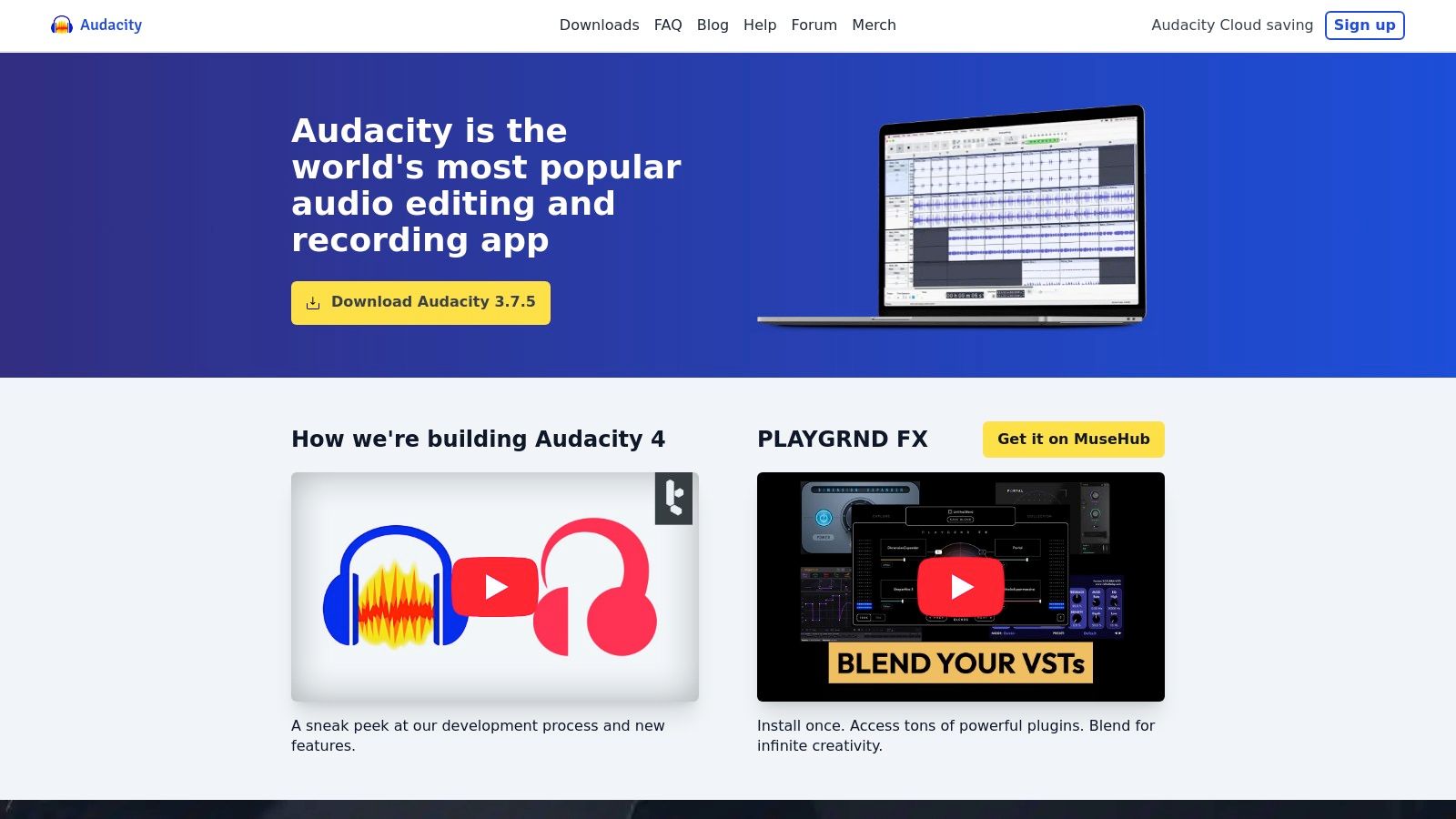
What makes Audacity a perennial favorite is its straightforward, function-over-form approach. While it may lack the polished user interface of its paid competitors, its capabilities are robust. It supports multitrack editing, allowing you to easily layer introductions, interviews, and background music. The massive, active user community means that tutorials, plug-ins, and troubleshooting guides are always just a quick search away, making the learning curve much more manageable.
Key Features & Considerations
- Core Editing Tools: Provides essential functions like cutting, copying, pasting, and deleting audio, along with a suite of built-in effects like equalization, compression, and normalization.
- Plug-in Support: Extends its functionality by supporting VST, LADSPA, and LV2 plug-ins, allowing users to add more advanced or specialized audio processing tools.
- Noise Reduction: Features a capable, built-in noise reduction effect that is highly effective for cleaning up common issues like background hiss or hum from recordings.
Best ForLimitationsPricingBeginners, Hobbyists, Budget-conscious creatorsUtilitarian and somewhat dated user interface, Lacks the advanced workflow features of professional DAWsCompletely free to download and use.
Practical Tip: Use the "Noise Reduction" effect by first selecting a few seconds of pure background noise in your track and clicking "Get Noise Profile." Then, select your entire audio clip and apply the effect to intelligently remove unwanted hiss.
6. REAPER
REAPER is a powerful and highly customizable digital audio workstation (DAW) that offers professional-grade features at an exceptionally accessible price point. As a piece of podcast editing software, it is revered by technical-minded creators for its stability, efficiency, and near-infinite flexibility. Unlike many competitors, REAPER provides a full-featured, unbridled editing environment without locking users into a subscription model.
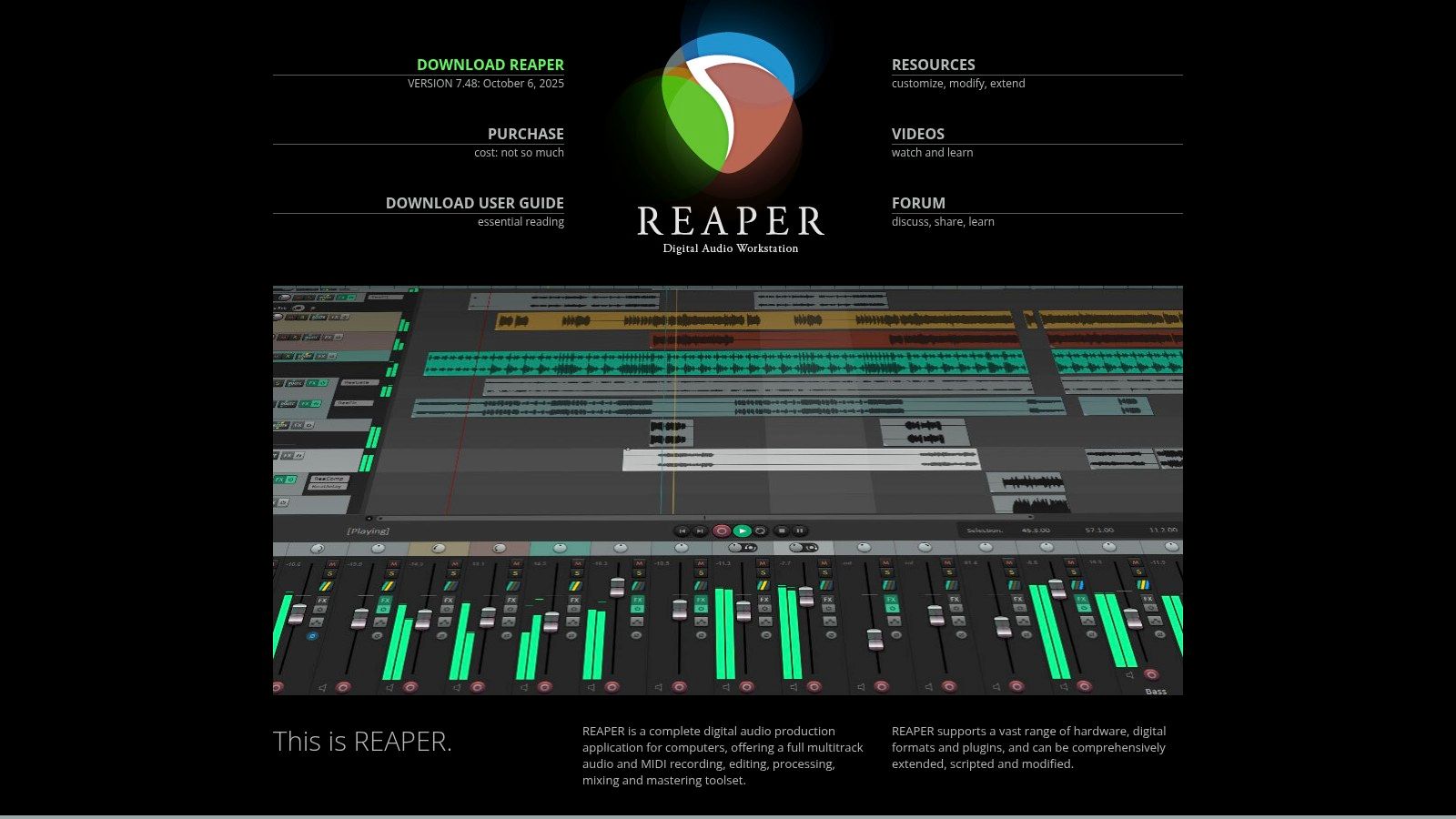
What truly makes REAPER stand out is its philosophy of customization. The entire interface, workflow, and feature set can be modified through scripts, custom actions, and extensions like SWS/S&M and ReaPack. This allows podcasters to build a bespoke editing suite tailored precisely to their needs, from creating one-click macros for common edits to automating complex batch processing jobs for an entire show archive.
Key Features & Considerations
- Extreme Customization: Create custom actions, toolbars, and menus to streamline your unique podcasting workflow, dramatically speeding up repetitive editing tasks.
- Lightweight and Efficient: The program is known for its small footprint and fast performance, running smoothly even on older hardware and with large, complex projects.
- Robust Routing and Mixing: Offers a highly flexible routing matrix that rivals even the most expensive DAWs, giving you complete control over your audio signal flow.
Best ForLimitationsPricingTechnical Users, Budget-conscious ProsSteeper learning curve, requires setup for podcast-specific featuresA $60 discounted license is available for personal use, with a commercial license at $225. Both include free updates through two full version numbers.
Practical Tip: Install the SWS/S&M Extension to unlock hundreds of new actions. A particularly useful one for podcasters is "Normalize loudness of selected items," which allows you to quickly balance the volume of different speakers or segments.
7. Logic Pro
Logic Pro is Apple’s flagship digital audio workstation (DAW), offering a powerful, one-time purchase solution for Mac-based creators. While renowned for music production, it is also some of the best podcast editing software available due to its comprehensive suite of dialogue editing tools, robust mixing capabilities, and extensive plugin library. It provides a professional step up from GarageBand with a familiar, intuitive interface.
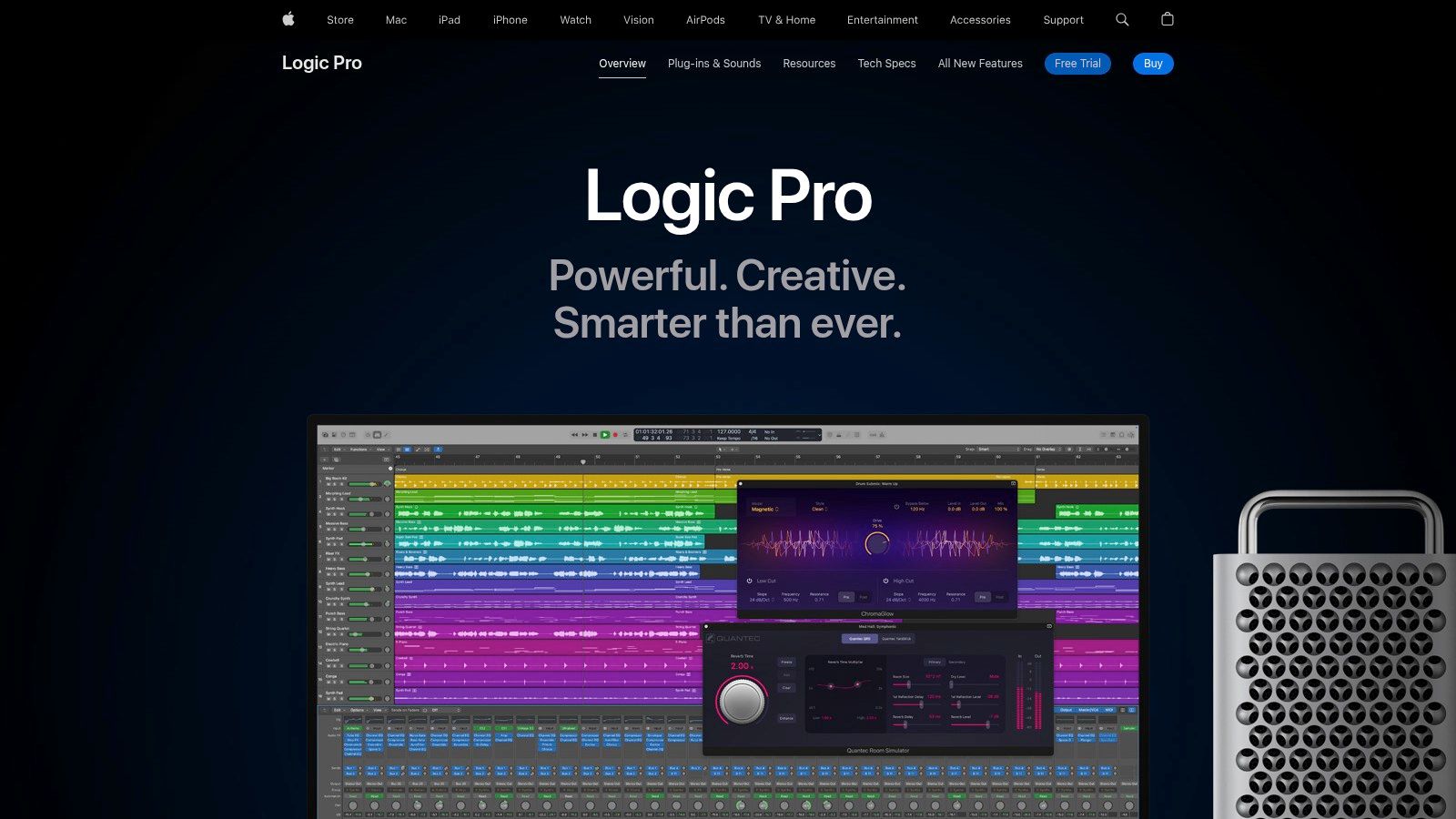
What makes Logic Pro a strong contender is its value proposition. For a single price, users get lifetime access to an immense collection of professional-grade effects, including excellent compressors, EQs, and noise gates, eliminating the need for many third-party plugins. Its seamless interoperability with GarageBand allows creators to start projects on an iPhone or iPad and finish them with Logic's advanced tools on a Mac.
Key Features & Considerations
- Take Comping: Easily record multiple takes of an intro or ad read and then quickly stitch together the best parts into a single, flawless performance.
- Built-in Professional Effects: Access a huge library of high-quality stock plugins, including de-essers, limiters, and channel EQs, to clean and polish your vocal tracks.
- Round-Trip Editing: Start an idea in GarageBand on your iPad and seamlessly transfer the project to Logic Pro on your Mac for final mixing and mastering without losing any data.
Best ForLimitationsPricingMac Users, Musicians-Turned-PodcastersMac-only software, lacks some podcast-specific automationA one-time purchase of $199.99 from the Mac App Store.
Practical Tip: Use the "Track Stacks" feature to group related audio tracks, like multiple host mics or all your sound effects, into a single, manageable channel strip. This simplifies your mix and allows you to apply effects to the entire group at once.
8. iZotope RX 11
While not a traditional digital audio workstation (DAW), iZotope RX 11 is an indispensable audio repair suite that many professionals consider essential. It’s the ultimate rescue tool for podcasters who’ve captured otherwise unusable audio. Think of it less as a primary editor and more as a surgical toolkit you use alongside another program to fix problems like excessive background noise, reverb, and distracting mouth clicks.
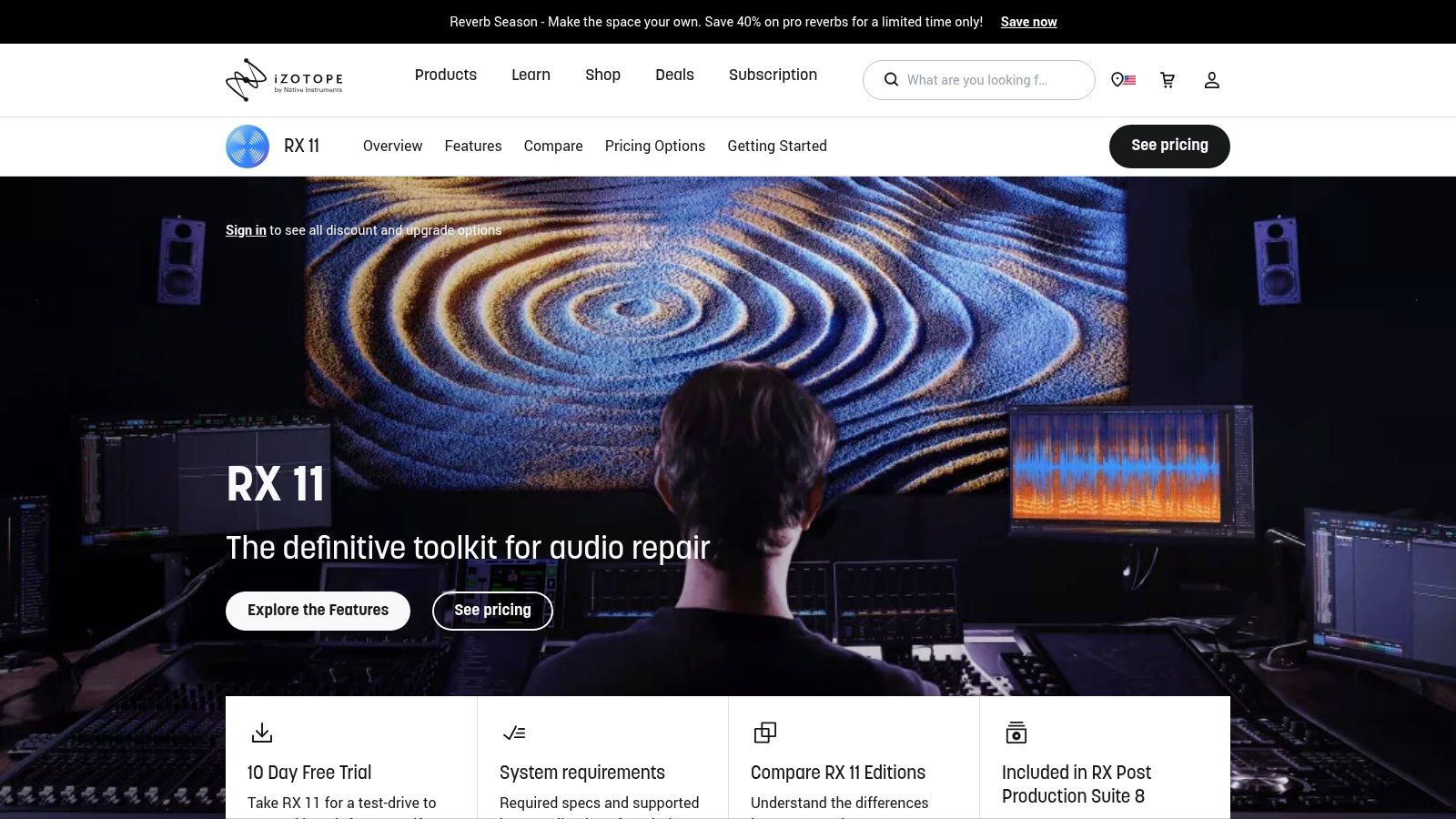
What makes RX 11 a game-changer is its intelligent, AI-powered repair modules. Its flagship Dialogue Isolate feature can separate spoken words from even the most chaotic background environments with astonishing clarity. This suite is one of the best podcast editing software add-ons because it empowers you to salvage recordings that would normally have to be discarded, saving countless hours and irreplaceable interviews.
Key Features & Considerations
- Intelligent Repair Tools: Modules like De-noise, De-reverb, and Mouth De-click are industry-leading solutions for cleaning up imperfect audio recordings.
- Spectral Editor: This visual editor allows you to see sounds like a dog bark or a door slam as visual artifacts and simply paint them away without affecting the core dialogue.
- Plugin & Standalone Editor: Use RX 11 as a plugin directly inside your main DAW (like Audacity or Logic Pro) or use the more powerful standalone editor for deep restoration work.
Best ForLimitationsPricingRescuing Problematic Audio, Pro-Level PolishingNot a standalone editor or DAW, can be pricey and complexStarts at $12.49/month for RX 11 Standard via subscription, or from $399 for a perpetual license.
Practical Tip: Use the "Repair Assistant" module first. It will analyze your audio and automatically suggest a chain of processing modules to fix common issues, giving you a fantastic starting point before making manual tweaks.
9. Alitu
Alitu is an all-in-one, web-based podcast creation tool designed to take the technical headache out of producing a show. Marketed as "the podcast maker," it streamlines the entire workflow from recording to publishing, making it one of the best podcast editing software choices for beginners and time-crunched creators. Its philosophy is built on automation and simplicity, allowing users to assemble, clean, and finalize an episode with just a few clicks.

What makes Alitu stand out is its end-to-end functionality combined with powerful, automated audio processing. It automatically applies noise reduction, levels volume, and handles other technical cleanup tasks, so you don't need audio engineering expertise. With built-in recording, a library of music, and integrated hosting, it truly is a complete podcasting solution in a single browser tab, perfect for those who want to focus on content, not complex software. For more on creating promotional content, discover the best podcast clip generators.
Key Features & Considerations
- Automated Audio Cleanup: Alitu’s "Magic" filters automatically process your recordings to remove background noise and ensure consistent loudness, saving significant editing time.
- Intuitive Episode Builder: A simple drag-and-drop interface allows you to arrange your audio segments, intro/outro music, and ads to build your episode visually.
- Integrated Recording & Hosting: Record solo or remote guest interviews directly in the platform and publish your finished episodes through Alitu’s optional built-in hosting service.
Best ForLimitationsPricingBeginners, SolopreneursLimited granular editing controls, Power users may find the features restrictiveStarts at $38/month for the full suite of tools.
Practical Tip: Use the "Remove mistakes" feature in the editor, which allows you to easily cut out filler words or errors from your audio by simply highlighting the text in the auto-generated transcript.
10. Podcastle
Podcastle is a collaborative, AI-powered platform that redefines the podcasting workflow by bringing high-quality recording, editing, and publishing into a single web-based application. As a comprehensive podcast editing software solution, it excels at simplifying remote interviews, providing separate audio and video tracks for each participant to ensure maximum editing flexibility. Its core strength lies in its accessibility and powerful AI features that automate complex editing tasks.
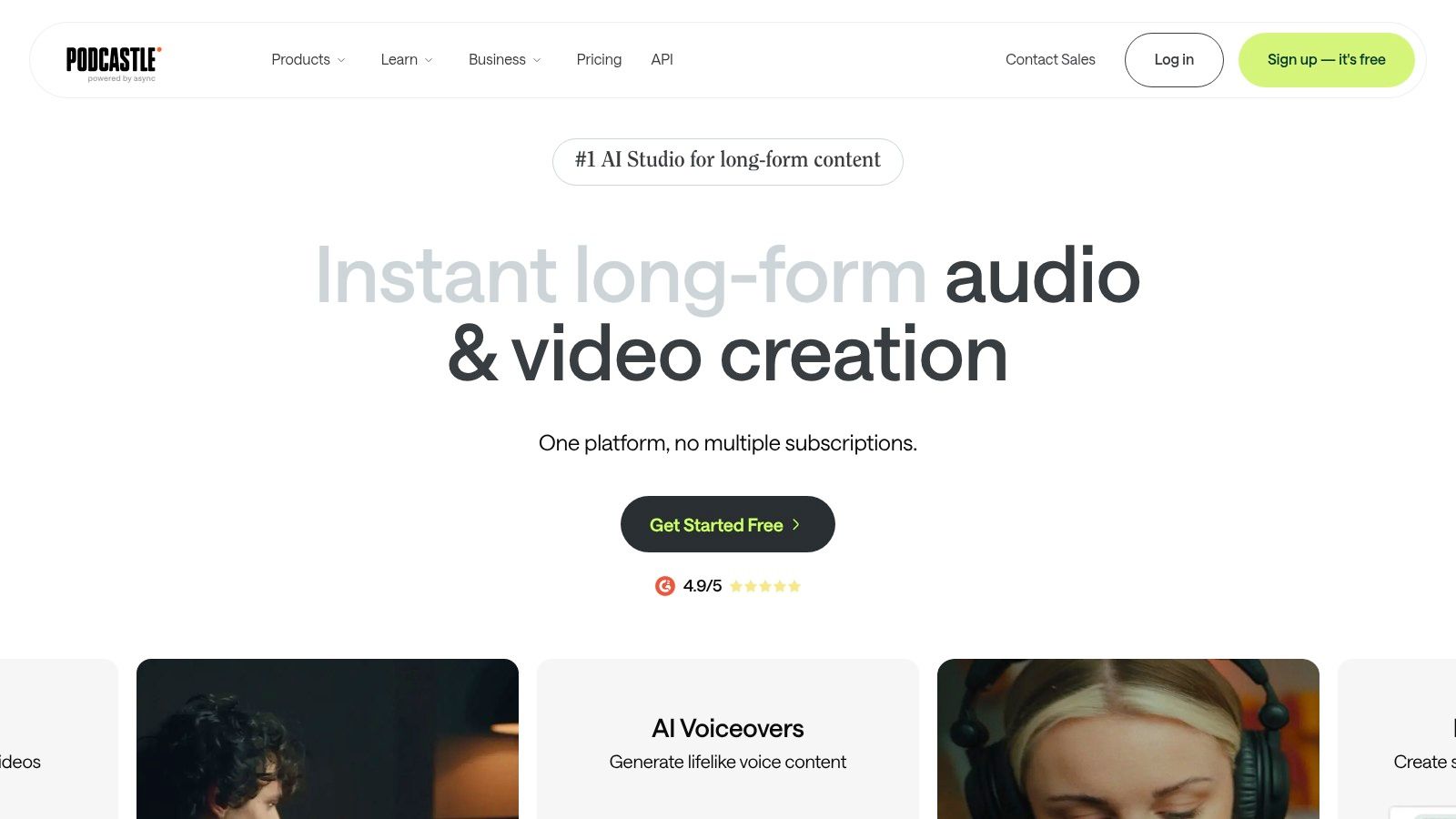
What makes Podcastle stand out is its "text-based" editing capability, allowing creators to edit their audio by simply editing the auto-generated transcript. This intuitive approach dramatically lowers the technical barrier for new podcasters. Combined with 4K video recording and built-in hosting, it offers a complete "studio in the cloud" for creators who value efficiency and collaboration without needing to download complex software.
Key Features & Considerations
- AI-Powered Editing: Automatically remove filler words ("ums," "ahs") and long silences with a single click using the "Magic Dust" feature, which also enhances speech clarity.
- Remote Recording Studio: Invite up to 10 guests to a recording session, with each participant's audio and video recorded locally in high fidelity to prevent internet-related quality drops.
- Integrated Hosting: After editing, you can host your podcast directly on Podcastle and distribute it to major platforms like Spotify and Apple Podcasts from the same interface.
Best ForLimitationsPricingTeams, Remote Interviews, BeginnersFree plan has limited hours and watermarked exports; fewer granular controls than traditional DAWsFree plan available. Paid plans start at $11.99/month (billed annually) for the "Storyteller" plan with more features and fewer limits.
Practical Tip: Use the "Revoice" feature to clone your own voice. This allows you to correct misspoken words or add forgotten sentences later by simply typing the new text, saving you from having to re-record entire sections.
11. Auphonic
Auphonic isn't a traditional DAW but rather an intelligent, automated audio post-production web service that acts as the perfect final step in your editing workflow. It excels at taking your already-edited podcast and applying a professional, broadcast-quality polish with just a few clicks. This platform is the secret weapon for podcasters who want consistently great-sounding audio without needing to master complex engineering techniques.
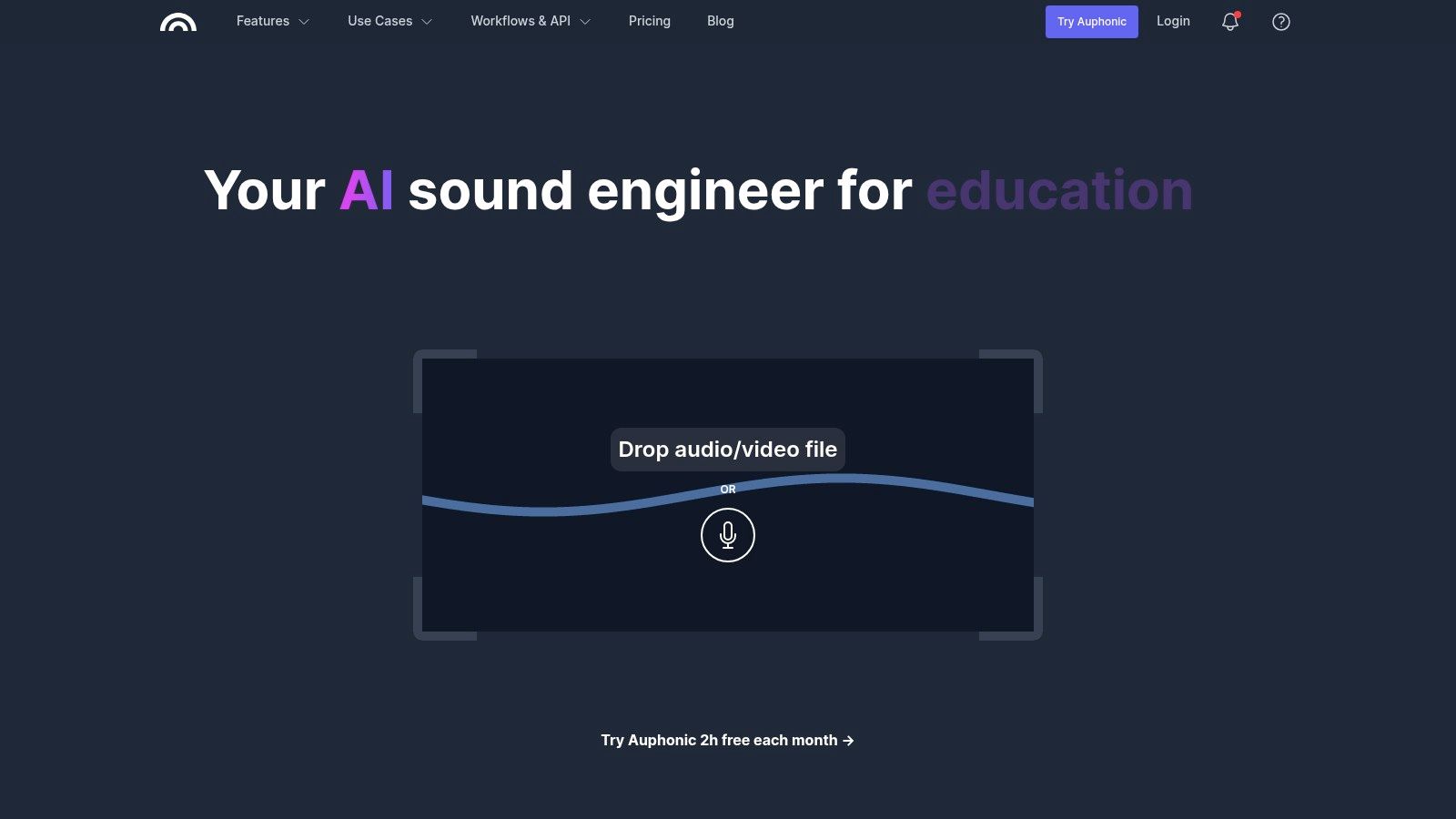
What makes Auphonic a standout choice is its powerful AI-driven algorithms. It automatically analyzes your audio and applies precisely what it needs, from loudness normalization to industry standards (LUFS), dynamic leveling to balance speakers, and adaptive noise reduction to clean up background hiss. For many creators, it replaces hours of manual tweaking with a simple, automated process, making it one of the best podcast editing software tools for finishing and mastering.
Key Features & Considerations
- Intelligent Leveler: Automatically balances the volume between different speakers, music, and other audio elements for a smooth, professional listening experience.
- Loudness Normalization: Conforms your final episode to podcasting and broadcast standards (e.g., -16 LUFS for stereo), ensuring consistency across all listening platforms.
- Automatic Noise Reduction: Its AI identifies and reduces unwanted background noise and hum without degrading the primary dialogue, a crucial step for recordings made in less-than-ideal environments.
Best ForLimitationsPricingCreators seeking a simple final polish, Batch processing workflowsLimited manual controls compared to a full DAW, Processing time counts against a monthly or credit-based limitFree plan offers 2 hours of processed audio per month. Paid plans start at $11/month for 9 hours, with pay-as-you-go credits also available.
Practical Tip: Connect Auphonic to your cloud storage service (like Dropbox or Google Drive) and set up a "watch folder." Any audio file you drop into that folder will be automatically processed by Auphonic and saved to a destination of your choice, completely automating your mastering workflow.
12. G2 - Audio Editing category
While not a piece of software itself, G2's Audio Editing category is an indispensable resource for anyone trying to find the best podcast editing software for their specific needs. It's a B2B software marketplace that aggregates thousands of verified user reviews, ratings, and feature comparisons for dozens of tools. This platform allows you to compare platforms like Audition, Descript, and Audacity side-by-side based on real-world user feedback.
What makes G2 uniquely valuable is its comprehensive filtering system. You can narrow down your options based on your operating system, business size, budget, and specific features you require. This data-driven approach moves you beyond marketing claims, providing a powerful snapshot of market sentiment and helping you validate which software truly delivers on its promises before you commit to a purchase or subscription.
Key Features & Considerations
- Side-by-Side Comparisons: Directly compare products on features, pricing, and user-reported pros and cons to see how they stack up against each other.
- Verified User Reviews: Gain insights from a large pool of authentic users, helping you understand the practical strengths and weaknesses of each platform.
- Advanced Filtering: Search for software based on specific criteria like "noise reduction" or "multitrack recording" to quickly find tools that match your workflow.
Best ForLimitationsPricingPodcasters in the research phase, Teams evaluating optionsSponsored placements can influence rankings, Not a direct software providerFree to use for research and comparison. You must visit the individual vendor websites to purchase the software.
Practical Tip: Use the G2 Grid® for Audio Editing to quickly visualize the market leaders. Focus on products in the "High Performers" and "Leaders" quadrants, as these have high user satisfaction scores and a significant market presence.
Top 12 Podcast Editing Software Comparison
Choosing Your Sonic Signature: Making the Final Cut
Navigating the landscape of podcast editing software can feel like standing in a recording studio filled with a dizzying array of knobs, faders, and meters. As we've explored, the "best" tool isn't a one-size-fits-all solution; it's the one that aligns perfectly with your workflow, skill level, and creative vision. Your final choice will define your production efficiency and ultimately, your show's sonic signature.
We've journeyed from the AI-driven simplicity of platforms like Alitu and quso.ai, designed to automate and streamline the entire process, to the surgical precision of industry-standard Digital Audio Workstations (DAWs) like Adobe Audition and REAPER. We also examined innovative text-based editors like Descript, which have revolutionized how creators interact with their audio content, making editing as intuitive as correcting a document.
Final Takeaways on Choosing Your Software
As you make your decision, reflect on the core needs of your production. Is your primary goal speed and efficiency, or do you require granular control over every sonic detail?
- For Beginners & Solopreneurs: Tools like Descript, Podcastle, and Alitu offer gentle learning curves and powerful, automated features. They minimize the technical burden, allowing you to focus on creating great content without getting lost in complex interfaces.
- For Audio Professionals & Ambitious Hobbyists: If you demand ultimate control and are willing to invest time in learning, a traditional DAW is unmatched. Adobe Audition, Hindenburg PRO 2, and REAPER provide the deep feature sets necessary for professional-grade sound design and mixing.
- For the Budget-Conscious: Don't underestimate the power of free, open-source software. Audacity remains a capable and reliable option for creators who are just starting out or have straightforward editing needs.
Actionable Steps to Making Your Choice
Before committing to a subscription or purchase, take these final steps to ensure you've found the right fit. Your choice of the best podcast editing software is a foundational decision for your show's success.
- Identify Your Bottlenecks: What is the most time-consuming part of your current workflow? Is it removing filler words, mixing multiple tracks, or mastering the final audio? Choose a tool that directly addresses and solves this primary pain point.
- Utilize Free Trials: Nearly every premium tool on this list, from Adobe Audition to Descript, offers a free trial period. This is your opportunity for a hands-on test drive. Edit a full episode from start to finish to experience the software's real-world performance and intuitiveness.
- Consider Your Growth Trajectory: Where do you see your podcast in a year? If you plan to introduce video, complex sound design, or multiple co-hosts, select a platform that can scale with your ambitions.
Ultimately, your podcast editing software is your creative partner. It should empower your storytelling, not hinder it. By carefully considering your specific needs, budget, and long-term goals, you can confidently select the platform that will help you craft a polished, professional, and captivating listening experience for your audience, episode after episode.
Ready to skip the tedious parts of editing and focus on creating? quso.ai leverages the power of AI to automate filler word removal, generate show notes, and create social media clips in minutes, turning hours of post-production work into a simple, streamlined process. Discover a smarter way to produce your podcast at quso.ai and reclaim your creative time.






.png)


